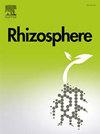Stratified soil profiles and arbuscular mycorrhizal fungi reshape plant water use strategy and enhance root development in arid mine waste dump restoration
IF 3.5
3区 生物学
Q1 PLANT SCIENCES
引用次数: 0
Abstract
Soil moisture is a pivotal constraint on vegetation establishment in spoil heaps of coal mining regions, particularly within arid and semi-arid landscapes. Optimizing the retention and utilization of soil water in these disturbed ecosystems is an urgent challenge with direct implications for ecological restoration. In a field-based factorial experiment conducted in a coal mine reclamation zone, we investigated two key variables: soil reconstruction strategy and microbial inoculation. The soil treatments included a homogeneous soil profile and a stratified profile. The microbial factor involved inoculation with the arbuscular mycorrhizal fungus (AMF) Funneliformis mosseae, compared against a non-inoculated control. Our findings revealed that stratified soil reconstruction significantly enhanced alfalfa (Medicago sativa) performance, root biomass increased by over 12.9 %, and average fine root length density by more than 22.5 % relative to homogeneous soil. The stratified configuration markedly improved soil water retention, creating a more favorable environment for root development and plant growth. AMF inoculation further amplified root water uptake and stimulated root proliferation. Notably, the combined treatment of stratified soil and AMF inoculation reshaped the plant's water acquisition strategy, reducing reliance on shallow (0–20 cm) soil moisture while enhancing uptake from deeper layers (20–40 cm and 40–100 cm). This synergistic approach, integrating engineered soil profiles with microbial symbiosis, proved most effective in promoting biomass accumulation and improving water-use efficiency. Collectively, these results offered actionable insights and a scientific basis for advancing vegetation recovery strategies in water-limited, post-mining environments.
分层土壤剖面和丛枝菌根真菌重塑干旱矿山排土场植物水分利用策略,促进根系发育
土壤水分是煤矿废弃地植被建立的关键制约因素,特别是在干旱和半干旱地区。在这些受干扰的生态系统中,优化土壤水分的保留和利用是一项紧迫的挑战,对生态恢复有直接的影响。在某煤矿复垦区进行了因子试验,研究了土壤重建策略和微生物接种两个关键变量。土壤处理包括均匀土壤剖面和分层土壤剖面。微生物因素涉及接种丛枝菌根真菌(AMF),与未接种对照比较。结果表明,分层土壤改造显著提高了紫花苜蓿(Medicago sativa)的生长性能,根系生物量比均匀土壤增加12.9%以上,平均细根长度密度比均匀土壤增加22.5%以上。分层配置显著提高了土壤保水能力,为根系发育和植物生长创造了更有利的环境。接种AMF进一步增加了根的吸水量,促进了根的增殖。值得注意的是,分层土壤和AMF接种的组合处理重塑了植物的水分获取策略,减少了对浅层(0-20 cm)土壤水分的依赖,同时增加了对深层(20-40 cm和40-100 cm)土壤水分的吸收。这种将工程土壤剖面与微生物共生结合起来的协同方法,在促进生物量积累和提高水利用效率方面被证明是最有效的。总的来说,这些结果为在水资源有限的采矿后环境中推进植被恢复策略提供了可操作的见解和科学基础。
本文章由计算机程序翻译,如有差异,请以英文原文为准。
求助全文
约1分钟内获得全文
求助全文
来源期刊

Rhizosphere
Agricultural and Biological Sciences-Agronomy and Crop Science
CiteScore
5.70
自引率
8.10%
发文量
155
审稿时长
29 days
期刊介绍:
Rhizosphere aims to advance the frontier of our understanding of plant-soil interactions. Rhizosphere is a multidisciplinary journal that publishes research on the interactions between plant roots, soil organisms, nutrients, and water. Except carbon fixation by photosynthesis, plants obtain all other elements primarily from soil through roots.
We are beginning to understand how communications at the rhizosphere, with soil organisms and other plant species, affect root exudates and nutrient uptake. This rapidly evolving subject utilizes molecular biology and genomic tools, food web or community structure manipulations, high performance liquid chromatography, isotopic analysis, diverse spectroscopic analytics, tomography and other microscopy, complex statistical and modeling tools.
 求助内容:
求助内容: 应助结果提醒方式:
应助结果提醒方式:


